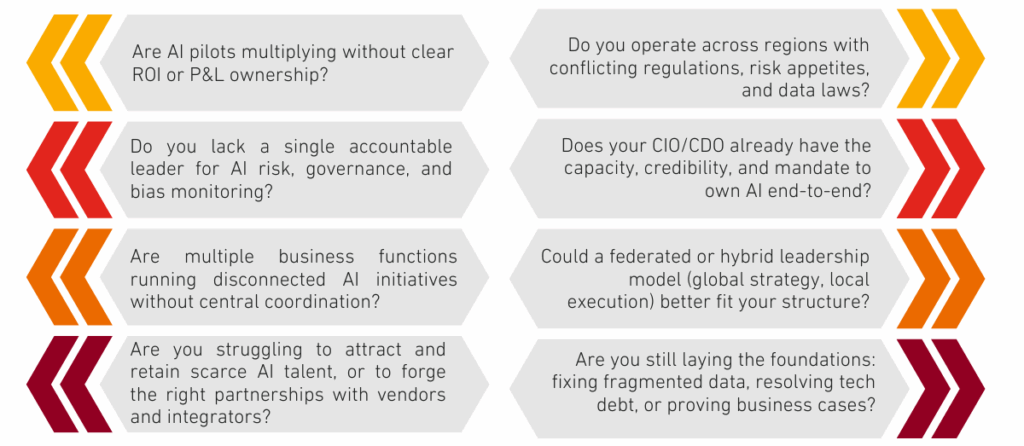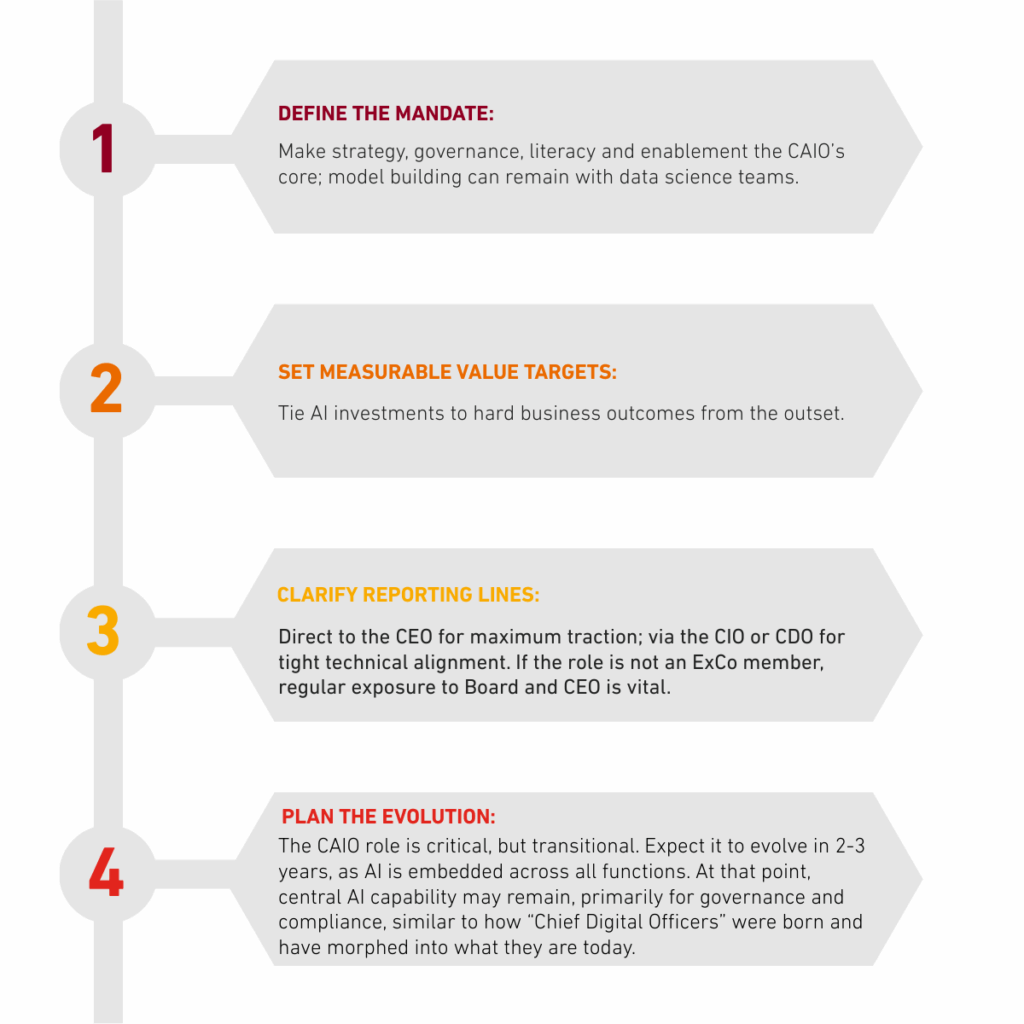Download the report >
AI has vaulted from pilot projects to board-level priority almost overnight. Some organisations are racing to appoint a Chief AI Officer (CAIO) to orchestrate the shift; others are embedding AI responsibilities into existing leadership roles such as the CIO or CDO.
Savannah’s Digital and Technology Leadership Practice, supported by our Talent Intelligence team, analysed the global senior AI leadership population and interviewed business leaders and CAIOs to build a deeper understanding of this relatively new position. There are approximately 1,800 people currently operating at C-level and of those hired in the past 12 months, 46% were promoted internally and 54% recruited from outside, signalling both the nascency of the role and the variety of approaches boards are taking. This report is written to help Boards, CEOs and CTOs chart the best AI leadership path for their organisations.
Brands like WPP, Nike, General Motors and Pfizer have publicised their own CAIO hires, with most making the appointment in the last 18 months. Others, like Ikea, have empowered their existing Chief Data & Analytics Officer to own the AI roadmap.
Whether via a CAIO, a CDAO, or an AI council, leading companies are being intentional about AI leadership. They are publicly vocal about how they govern AI, from JPMorgan’s CEO discussing AI oversight in banking, to Ikea signing the EU AI Pact for governance compliance. Because getting AI right is both a competitive opportunity and a serious risk management exercise.
Quantitative research by Savannah’s Talent Intelligence Practice August 2025:

THE STATE OF ENTERPRISE AI
For many enterprises, the reality of AI adoption has not necessarily matched the early hype. Following the surge of investment after ChatGPT’s launch, boards pushed their organisations to run fast, experiment widely, and “not get left behind.” The result has been a wave of pilots and proof-of-concepts, but often little clarity on how these translate into sustained business value.
CFOs, in particular, are now scrutinising rising Opex bills as companies take out enterprise-wide licences for tools like Copilot, ChatGPT or Gemini, often without corresponding productivity gains. While AI can draft emails, summarise documents, or create campaign storyboards faster, these small improvements rarely add up to wholesale efficiency or headcount reduction. Instead – according to one of Savannah’s CAIO contacts – most pilots remain stuck in “POC purgatory”, promising experiments that never reach production at scale.
A major reason is the “last mile” gap. Central AI teams may build prototypes, but unless functional leaders in marketing, supply chain, finance, or product embed them into their own processes, the tools never achieve traction. Adoption requires business ownership, not just a technical push. Many boards also underestimated the difficulty of tracking ROI: few organisations have clear mechanisms for measuring productivity gains or linking AI back to operating leverage and topline growth.
Agentic AI (autonomous agents capable of reasoning, decision-making, and interacting with other systems), often described as the “next frontier,” is beginning to surface in board conversations, but here too the gap between hype and reality is wide. Most enterprise use cases remain immature, with fragile interoperability and recurring hallucinations, making it risky to scale prematurely. Without disciplined leadership to test, validate, and target agentic AI where it creates genuine differentiation, it risks becoming yet another layer of expensive experimentation.
In short, for some enterprises, AI has shifted from dazzling promise to a more sober reality: rising costs, patchy adoption, and a lack of last-mile execution. The challenge for boards now is to turn experimentation into enterprise-wide impact.
So, do you need a CAIO? Below are the arguments on both sides, written for boards and C-suites that need to move quickly, but thoughtfully.
SIX REASONS TO GO THE CAIO ROUTE
1. Turn AI from experiments into bottom-line impact
If AI proof‑of‑concepts are stacking up with no clear owner, a CAIO installs P&L discipline. They set value targets up‑front, kill “pilot‑itis,” and ensure every model links to revenue growth, cost reduction, or risk mitigation.
For one financial services CAIO, this means prioritising a handful of high-value use cases each year, while enabling business units to experiment safely with low/no-code tools. The combination stops scattershot spend and delivers visible ROI.
And as far as ROI is concerned, the return can certainly justify the investment. One prominent CAIO in Savannah’s network describes generative/agentic AI as transformative to his business – driving a potential 30–40% impact on revenue / P&L, compared with the 5% uplift typically achieved through traditional analytics. Elsewhere, the CAIO of a global tech services business has been tasked with driving an additional $200m in annual revenue while keeping the cost of sale flat – a mandate tying AI directly to financial outcomes, which the business is on track to deliver.
2. Establish AI trust and governance
AI is only as good as the guardrails around it. Hallucinations, bias, and other failures can carry serious compliance consequences, as well as reputational risks. The case of Air Canada being held liable after its chatbot gave misleading advice on bereavement fares – and Commonwealth Bank’s recent reversal of a voice bot rollout after customer outcomes deteriorated – show how quickly weak governance can escalate into legal, financial and reputational risk.
Outside of this, ‘shadow AI’ is proliferating across the enterprise; A recent Harmonic Security study found that the average enterprise within their customer base is already running 254 AI-enabled applications, many procured outside central IT. A CAIO can rein in this indiscriminate usage, providing a single point of accountability for risk and model governance. They will ensure systems are stress tested, bias is actively monitored, and high-risk rollouts are stopped before they reach production. This gives regulators, auditors, and customers confidence that AI is being deployed safely and fairly.
3. Break down silos across the enterprise
AI initiatives are emerging across every function: from sales and supply chain to HR and legal. But without a centralised strategy, oversight, and governance, they often move in conflicting directions.
Without this central orchestration, functions may compete for resources or deploy incompatible tools, undermining the company-wide benefit.
For example, the CAIO of a major tech business positions her team as custodians of AI playbooks, adoption plans, and cross-functional collaboration projects with HR, Finance, and other functions – ensuring workflows are coordinated centrally and business divisions remain aligned. The result is coordinated investment and reusable capability instead of scatter‑shot spend
4. Drive adoption through education and change leadership
Automation threatens existing workflows, so frontline adoption is rarely smooth. A CAIO pairs technical know-how with change management muscle: upskilling staff, redesigning roles, and ensuring humans stay in the loop.
Crucially, this change leadership extends all the way to the top. The CAIO of one major bank has rolled out a structured AI education programme for the company’s board and senior executives, combining short foundational sessions for non-executive directors with a six-month Cambridge University-led course for top leadership to embed “AI-first” thinking into long-term strategy.
An approach that has proven highly impactful in closing communication gaps and driving behavioural change. With both workforce confidence and executive literacy high, AI programmes are scaling instead of fizzling out.
5. Keep pace with accelerating competition
The competitive clock speed of AI is relentless. New vendors, regulations, and model breakthroughs appear quarterly. A CAIO’s role is to track this evolving ecosystem while the rest of the C-suite focuses on current priorities.
One CAIO in Savannah’s network cautions that some companies are wasting resources by building bespoke AI tools where vendors already provide embedded capability (e.g. SAP has promised 400 embedded AI use cases by the end of 2025). Instead, she’s helping her organisation use platform AI (e.g. in SAP, Salesforce, Microsoft) for commoditised functions and reserve custom development for core areas of intellectual property.
But keeping pace isn’t just about monitoring the market, it’s also about talent. Technology is widely available, yet genuine AI expertise is scarce. An effective CAIO can build a world-class AI function: they know what good looks like, can attract and retain top talent, create the conditions for specialists to thrive, and build partnerships with major technology providers and integrators to scale capability across the organisation.
6. Cut through the hype and protect against wasted investment
Boards today are being bombarded with AI buzzwords and vendor promises, often without the knowledge to separate genuine opportunity from oversold solutions. With more than 70,000 AI startups worldwide, and 68% of large companies planning to invest $50–250 million in AI over the next year, according to KPMG research, the pressure to “do something with AI” is immense.
But one CAIO and PE board advisor emphasises that the next phase will require moving beyond fragmented adoption of multiple disparate tools. Agentic AI calls for the re-engineering of entire business processes with an “agentic-first” mindset – demanding bold change leadership to reshape operating models so AI is built into the fabric of how work gets done, rather than bolted onto legacy processes.
By ruthlessly focusing on what matters for the company’s specific needs, a CAIO helps boards avoid costly missteps and safeguards against wasted investment in shiny but low-value AI initiatives.
REASONS YOU MIGHT SKIP – OR AT LEAST DELAY – A CAIO HIRE
- Your CIO and/or CDO already has the vision and capacity
If your existing technology and/or data chief already sits on the executive committee, commands board confidence, and has the skills and bandwidth to lead AI end-to-end, then adding another C-level seat may complicate accountability. In this case, the better answer is often to strengthen their mandate with dedicated AI resources. Hiring an AI-focused Director/VP to report to the CDIO may be the most sensible first step. What’s critical, though, is to remember that AI is a business-wide initiative; boards who see it as the ‘preserve of the IT department’ are falling at the first hurdle. - A federated or hybrid leadership model may serve you better
Some diversified businesses find that AI gains traction faster under a federated structure: a lean central hub sets governance standards, while embedded leads in business units drive adoption. One global CPG organisation delivered a multi-million dollar impact on P&L by embedding AI business partners in functions. - You operate across diverse regulatory and operational landscapes
AI regulation and governance vary widely across regions: the EU enforces strict compliance through the AI Act and GDPR, the US leans toward innovation, and China adds its own frameworks. Organisations must also contend with data residency, sector-specific rules, and varying workforce laws. Expecting one global CAIO to manage this patchwork may risk blind spots and slow responses, making regionalised or hybrid models more effective. In these, a global leader sets broad strategy while regional AI Directors ensure local compliance. This mirrors how many organisations already structure data and cybersecurity leadership, balancing global consistency with local execution. - You’re still laying the foundations
If data remains fragmented, tech debt is high, business cases are unproven, and the organisation is not yet change-ready, a permanent CAIO may be premature. In these circumstances, an interim AI leader or task force can lay the groundwork, prove production-level wins, and hand over to existing leadership once the basics are in place.
It’s also critical to recognise the role of existing technology leaders and tech investment as a whole. Many CDIOs are telling us they are now being asked by their Board to deliver “game-changing AI” when the basics of technology have been underfunded for a long time. Many have been asking for years for investment to replatform onto modern cloud infrastructure, retire ageing systems, and invest in data quality and standardisation, but when budgets are squeezed, the Capex is spent elsewhere. Without this foundation, AI initiatives risk being layered on top of fragile, fragmented architectures – exacerbating technical debt rather than creating sustainable value. In these scenarios, giving your CDIO the tools, budget, and mandate to modernise first is an important step before any permanent CAIO appointment.
A QUICK LITMUS TEST – YES OR NO?

If the answers to the questions on the left are “yes,” you likely need a CAIO or equivalent to provide leadership, governance, and momentum.
If the answers to the questions on the right are “yes,” you may be better served by delaying a CAIO and strengthening existing leadership or adopting a hybrid model until maturity increases.
WHERE TO START

CONCLUSION
For many industries, the winners of the next decade will be created in the next two years. Avoiding the question of AI leadership is not an option – those that delay decisive action risk being left behind. Every business needs clarity on who owns the mandate; the real question is what form that leadership should take, and where it should sit in the organisation. For many, it will be a permanent CAIO reporting directly to the CEO; for some, an interim leader who builds momentum and hands back to existing structures; and for others, it may mean empowering an exceptional CIO or CDO with the right support beneath them. The winners will be those that embrace this role in the right way for their context, ensuring accountability, governance, and focus amidst the hype.
At Savannah, we help boards cut through the noise to make confident, informed decisions on AI leadership. We help you to define the mandate, determine how success will be measured, and work through exactly what type of leader is required and where they should sit in the organisation. Once defined, our teams work at pace to deploy the right permanent or interim leadership solution for you.
Our advice is powered by Savannah’ s own proprietary AI platform, MapX, which provides unrivalled visibility of the global leadership landscape. Combined with our Partners ’ decades of functional expertise in AI, digital, and data, we deliver leadership solutions that are precise, practical, and tailored to each client’s context – turning AI from experimentation into lasting enterprise impact.
Key Contacts: Nick Davies, Lily Haake, Sam Sullivan, Ingrid Malo




